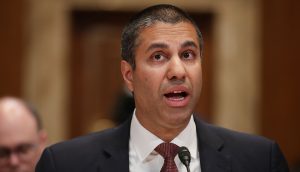In its bid to win the 5G race against country-competitors like China, the US Federal Communications Commission (FCC) has moved forward with a selection of spectrum sales over recent months. Unfortunately, competing bids from government and corporate interests on the mid-range bands of the spectrum – aptly named the “Goldilocks” bands – may create delays for America’s next-generation of internet.
President Trump’s administration has a particular interest in pushing out the first 5G due to many technologies that will be tapping into the new capabilities – such as self-driving cars, smart devices, and advanced surgical applications. “If 4G is like a lake, 5G will be an ocean,” Erik Kruse, Ericsson’s Networked Society evangelist and director of the Networked Society Lab, told IBTimes UK in a 2015 interview.
Paul Triolo, a technology policy analyst at Eurasia Group, stated that “[t]he US needs to sort out its use of mid-band frequencies… If China is able to deploy at scale mid-band spectrum and this enables Chinese companies to get faster to deploying applications like autonomous vehicles, that is an advantage for other markets.”
As the Pentagon’s advisory board stated earlier this year, the US is already operating at a commercial disadvantage when compared to other countries due to how much of the spectrum spanning 5G is already allotted for military and government agency use. Consequently, the FCC’s current chairman, Ajit Pai, has been attempting to push sales of available Goldilocks-friendly bands but has encountered resistance from existing stakeholders.
Of particular interest to many American tech firms is the highly coveted 6GHz – a frequency that has billion-dollar players like Apple, Microsoft, Facebook, and Google pitted against the likes of Swedish multinational Ericsson for right of use. On one side, 11 global telecom companies are supporting the FCC’s proposal to utilize this frequency without a license for home WIFI but Ericsson, amongst others, is contesting this use will interfere with their existing communication satellite operations.
Another hotly contested frequency is what’s known as C-Band which, up until this point, has been used by numerous broadcasters to upload and download their content via satellite. The FCC’s plans to open this up these frequencies for 5G use has raised concerns from those who already access these bands for programming. The C-Band Alliance, a consortium of satellite service providers, has very recently proposed clearing out 300MHz of spectrum for nationwide 5G deployment. It's believed that this will satisfy the need to balance the current needs of broadcasters and programmers against the future needs of 5G users.
However, it doesn’t end there for Pai as the National Oceanic and Atmospheric Association (NOAA) has made it known that opening the 24 GHz band to other users could impact the use of their weather satellite. In a hearing before members of Congress on May 2019, NOAA assistant secretary Neil Jacobs stated that this “would result in roughly a 77 percent data loss from our passive microwave samples” which would bring accuracy down to pre-1980 levels. For hurricane forecasts, it could reduce prediction lead times “by roughly two or three days.”.
Pai did successfully negotiate an agreement with NOAA and Nasa to limit 5G data transfer so that it does not impact satellite communications. The FCC will be able to move forward with its plan to auction off 24 GHz and hopes they will be able to resolve the problems with 6GHz this autumn.
Through all of this, Pai remains undaunted by the work ahead and asserts that the US will be making the first leap for 5G. “We have more commercial deployments, more 5G subscribers and more spectrum dedicated for 5G than China… As the FCC continues to execute its 5G plan, the United States will stay at the forefront of 5G.”
























